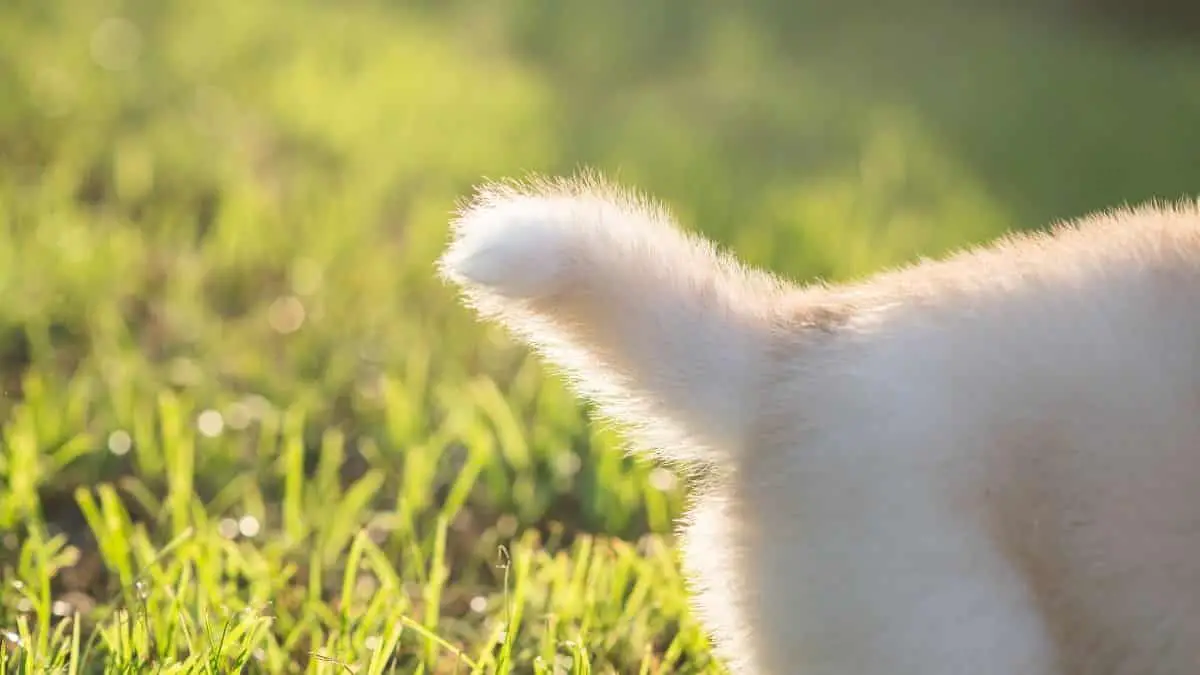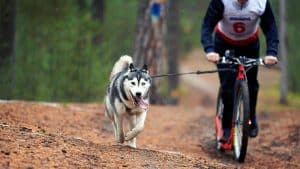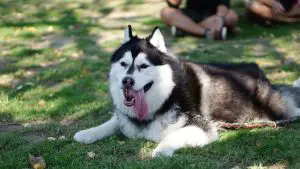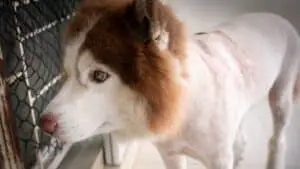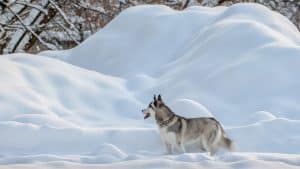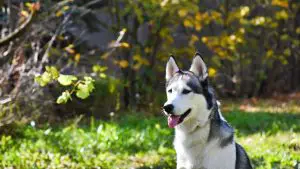Why Does Siberian Husky Have Curly Tail? You Might Be Surprised
Siberian Huskies are a perfect mix of the wild features of wolves and the endless goofiness of dogs! There is nothing you would wish to question about this majestic, intense breed- perhaps except for their tails. The curly, bushy Siberian Husky Tail is quite an amusing aspect, but it comes with questions.
You might be wondering why the tail of this breed curls the way it does and whether all huskies have it or not. There are questions galore! As you read further, you will find all the answers you seek. Read on for a comprehensive account of the endearing Siberian Husky Tail!
Table of Contents
The Siberian Husky Tail
Before you read further, it is essential to gather all the factual information about Siberian Huskies’ tails. It is essential to note that these dogs’ tails are not precisely “curly”- instead, they are sickle tails.
As per the breed standards, Siberian Huskies do not sport “curly” tails. Some breeds that do have curly tails, however, include Pugs and Shiba Inu.
The Differences In Curly Tails
“Curly” is a broad word that people use to describe dog tails that curve to a great degree. Since this is the case, you must know of the variations even amongst curly tails.
Purely Curly Tails
Bulldogs and Pugs have curly tails that look like corkscrews. The peculiar shape comes from an anatomical phenomenon where their vertebrae are either wedge-shaped or have fused. The medical term for it is “hemivertebrae.”
Curly tails wrap upwards in a tight arc, almost following the line of the dog’s spine. When a dog with a curly tail is attentive, the tail appears to coil up stiffly. When these dogs are not working or are relaxed, they carry their tail over their backs like a plume.
Sickle Tails
Another type of curly tail is the sickle tail- the kind that Siberian Huskies flaunt.
The main difference between a curly tail and a sickle tail is the appearance and flexibility. On the other hand, sickle tails are more flexible and relaxed- they wrap towards the back of the dog in a looser arc.
Siberian Huskies have sickle tails that curve over their backs when they are attentive- similar to pure curly tails. However, they tend to carry their tails in a low position when they are calm. The Siberian Husky Tail has a fox-brush form.
It is acceptable to use the terms “curly” and “sickle” interchangeably since they communicate a similar description.
Pure curly tails stay in that position since they arise from a deformity. Sickle tails, however, can reflect the physical as well as the emotional state of your dog. Your Husky can hold the tail in a high and curly or a low and loose manner.
Why Do Siberian Huskies Have Curly Tails or Sickle Tails?
Siberian Huskies are a breed of the north, branching out from the genetic family of the Spitzes. Typically, most breeds that are a part of the Spitz family have sickle tails or curly tails. Most researchers conclude that this feature is due to the region’s climatic conditions that the breeds hail from- that is, harsh and cold.
Since the natural area where Siberian Huskies come from is frigid, their tails are equipped to aid in their survival within such conditions.
Siberia has an arctic-like environment, and Huskies were initially bred exclusively in this region. Their bushy, curly, or sickle tails developed into handy shields against the cold. The curve of the Siberian Husky Tail makes it very easy for the dogs to cover their head and face while lying down. It helps them stay warm and guard against the cold when they are resting.
It is not sure whether curly tails are a product of intensive selective breeding or natural evolution. The consensus is that both of these factors play into the narrative with equal significance. You will see that many other breeds that hail from cold regions have curly or sickle tails in common if you observe closely.
The tails of Siberian Huskies curl up, especially when they are excited or happy. If your Husky is feeling tired or overwhelmed, the tail may assume a limp form. Your Husky might drag the tail in such a mood.
The Tails Of Siberian Husky Puppies
The tail’s curl is a common cause of concern and curiosity among people with Siberian Husky puppies. On average, most Husky puppies begin to develop a curly or sickle tail when they are near the age of four to six months. Before this age, they generally have trailing tails.
If you have a husky puppy and the tail has not curled upwards, you must not worry. All dogs grow at different paces, and your puppy’s tail may develop a sickle shape a little later.
The curve and sickle-like form of the Siberian Husky Tail relies upon the lineage, degree of breeding, and parents of children the dog. If the mother and the father of a puppy have finely curled tails, the poppet has excellent chances of developing a similar one.
What Is The Siberian Husky Tail And Its Sickle Shape Capable Of Expressing?
As you may already know, the tail of a dog speaks volumes about the canine’s mood. Siberian Huskies are not an exception to this.
When the tail of a Husky is in a gentle curve over the back, it is safe to say that the dog is normal, calm, and happy. The curl of the tail will be soft and flexible.
If a Siberian Husky coils the tail in a tight arc over the back, you must know that the wolfish dog is alert and perhaps apprehensive. The curl of the tail in this state will be bristly and rigid.
A thrilled Siberian Husky will, like any other breed, wag the endearing tail in a flurry. When this happens, the tail can either straighten out or wag while maintaining the sickle-shape.
If the tail of a Husky is not curly but low and straight instead- with the hackles up- the canine is defensive. It is best to step away from a Husky in a defensive posture. In this state, any degree of provocation may result in an unpleasant encounter!
The Reflection Of Breed Quality In A Siberian Husky Tail
People worldwide have been led to believe that the curl of a Siberian Husky Tail is an indicator of the breed’s purity. However, it is untrue- the extent of the curve of a Husky’s tail does not reflect quality.
A Siberian Husky with a high, fluffy sickle-shaped tail does not flaunt a purer and better bloodline than one that has a less curly tail. You should note that the shape and condition of the tail do indeed contribute to the dog’s overall quality, but it is only an indicator.
The misconception arises from the American Kennel Club’s breed standards for Siberian Huskies that display a “show dog quality.”
The American Kennel Club takes the curl of the tail of a Siberian Husky into consideration when forming a judgment on the quality. However, this aspect comes into play only when the dog is in a “show dog” category. There is a clear differentiation between show dogs and working dogs when it comes to breed standards.
For working Siberian Huskies, the American Kennel Club has outlined breed standards taking multiple factors into account. The overall weight and size, coat, paws, and posture of the dog are aspects that dictate the breed standards for working Huskies.
Things To Keep In Mind About Your Siberian Husky
It is undeniable that Siberian Huskies’ curvy, fluffy tail is endearing and desirable in your companion. If you have a Siberian Husky, you should keep certain things in mind to help your dog remain at the peak of good health.
The Curl Of The Tail
Are you worried about your Husky having an intensely-curling tail or a tail that stays low and straight? If yes, then you must know that every dog has a different type of tail. Some Huskies have tails that curl intensely, and others have sickle-shaped tails. There is another possibility when it comes to Siberian Husky Tail types, and that is, remaining low.
If your concerns persist, it would be best to take your dog to a veterinarian. The doctor will be able to explain the various possibilities that are behind the shape of the tail of your Siberian Husky. It will help and perhaps put your mind to rest!
The Condition Of The Back
You need to be aware that back problems such as scoliosis are not limited to humans. Dogs can suffer from such issues too. While Siberian Huskies have tails with a natural curve or curl, sometimes these dogs may have scoliosis.
The curve of the tail may not be a good indicator for you to recognize this problem since the tail of this breed is supposed to be curly in the first place. The best way to make yourself sure of the health of your dog’s back is to search for abnormal curves.
Mental Health
You can judge the mental health of a dog by observing the demeanor of the canine’s tail. If your Siberian Husky does not curl the tail and keeps it low all the time, your dog may be feeling depressed or stressed out.
A stressed-out and sad Husky will have a low, dragged-out tail. Here are some other indicators of depression and stress in dogs:
- Withdrawal
- Inactivity
- Lack of excitement
If your Husky displays any of these symptoms in addition to a low tail, you must consult a doctor. A veterinarian or dog behavior therapist will be able to help you identify the roots of the issue and make your pup happy again!
Frequently Asked Questions
There is a multitude of questions about the Siberian Husky Tail. Here are some typical questions, along with their answers:
Do all Siberian Huskies have curly tails?
No, not all Siberian Huskies flaunt curly or sickle-shaped tails. Even amongst Huskies with such tails, the extent of the curve can vastly vary.
Some Siberian Huskies may have tails that are long and grounded. Such tails have received the term “trailing tails.”
When does the tail of a Husky become curly?
There is no concrete timeframe for developing a curly tail in Siberian Huskies- or any other breed. A Siberian Husky Tail will most likely begin curling upwards and over the back around the age of six to eight months. Some Husky puppies may never have a tail that curls, while some may have a richly-curved tail even before they turn four months old.
What is the breed standard for Siberian Huskies?
According to “The Complete Dog Book 20th Edition,” an official publication of the American Kennel Club, Siberian Huskies are original working dogs. They are medium in size, with a lightness in gait and a compact body structure. The body of a Siberian Husky should be thick with fur- but without coarseness.
Siberian Huskies should not carry too much weight- they should fall into the 35-60 pounds category. The weight should be in proportion with the height, with any excesses of weight and appearances of bones being subjects for a penalty. The maximum height for Siberian Huskies is 23.5 inches for males and 22 inches for females.
When it comes to the facial features of Siberian Huskies, the AKC considers proper eye-spacing and friendly expressions to be desirable. Ears should be medium and triangular.
There is a vast array of factors through which the AKC judges a Siberian Husky. The quality of the coat, the color, and even the gait are essential aspects.
To Sum Up
Siberian Huskies are elegant dogs with their lupine features and intensely loyal minds. They are fantastic to look at while also being reliable working dogs. An exciting aspect of their appearance is their tail. The Siberian Husky Tail is sickle-shaped or curly, with a gentle arc over the back. It rises from the need of this breed to keep the body warm in a cold climate.
The American Kennel Club has a set standard to determine the quality of Siberian Huskies. This breed’s most important characteristics include but are not limited to medium size, balanced proportions, and freedom of movement.

